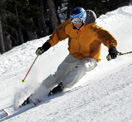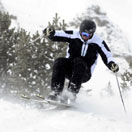This word (friction) has been in my head ever since Harald started talking about it with me a week or so ago in Colorado. It is not a term that I have typically heard in relation to skiing. Usually when I think of snow, especially hard snow or ice, the concept of friction at least intuitively seems out of place.
But Friction is what Harald was able to have me produce on the snow, and for me it was a level of control that I had never experienced before. It has now become a mental image that I will take with me each time out. When I experience it, I know that my weight is foreward and all the essentials are in place allowing me to carve tight, high friction turns.
Friction cannot happen when the hips are behind the feet. From this position, each move creates more speed, which is the opposite of friction.
After experiencing this, I now realize that racers dance between creating friction when they need it and gliding without it when they want to keep and/or generate speed.
Anyway that is my word for the day, FRICTION!!! Every good skier needs to be able to create it in edge lock carved turns.
Friction
32 posts
• Page 1 of 3 • 1, 2, 3
It's all about having pressure on the front of the skis. The only way to accomplish this is to keep the hips forward. The exercise that Harald invented for me, carved traverses with the inside leg scissored forward will give you the feeling. Make sure the hip on your outside leg comes forward of the same foot. Once you feel this, you can look to duplicate it in linked turns.
One thing is for sure, it's kind of like an orgasm, once you feel it, you know it, and when it is not occurring it is also very easy to spot.
When I skied with Max 501 last year he sent me an e-mail before the trip telling me that he was really bending his skis. I replied that I had no real experience of bending the skis. Now I understand what it means to bend the ski. This is another way of phrasing it. If you are forward enough that the pressure on the ski bends it some, you are in the poistion to produce friction.
The other part that for me also has to be in place, is skiing from an upright position vs having some bend at the waist. Bending at the waist is usually a substitute for having the hips forward in that it does get the weight more forward some, at least enough to prevent the skis from running away. The increased leverage that occurs from the upright position is truly amazing. Any attmept to increase tipping or counterbalancing movements are immediately translated to the skis and higher edge angles are immediately produced, thus adding to the experience of friction.
One thing is for sure, it's kind of like an orgasm, once you feel it, you know it, and when it is not occurring it is also very easy to spot.
When I skied with Max 501 last year he sent me an e-mail before the trip telling me that he was really bending his skis. I replied that I had no real experience of bending the skis. Now I understand what it means to bend the ski. This is another way of phrasing it. If you are forward enough that the pressure on the ski bends it some, you are in the poistion to produce friction.
The other part that for me also has to be in place, is skiing from an upright position vs having some bend at the waist. Bending at the waist is usually a substitute for having the hips forward in that it does get the weight more forward some, at least enough to prevent the skis from running away. The increased leverage that occurs from the upright position is truly amazing. Any attmept to increase tipping or counterbalancing movements are immediately translated to the skis and higher edge angles are immediately produced, thus adding to the experience of friction.
Balance: Essential in skiing and in life!
-

jbotti - Posts: 2188
- Joined: Fri Nov 28, 2003 10:05 am
Scissored forward just means that the inside foot and ski is substantially in front of the outside foot and ski (similar to what occurs when you walk in that at one moment your left foot (analogous to your inside foot) will be substantially in front of your right foot and leg). As the inside foot comes forward substantially it draws the hips over and in front of the foot of the outside ski. This is the position of control when skiing and an important position to find and stay in.
As for what it resembles, it is very simialr to carved garlands or carved traverses where one locks the edges and carves a semi circle back up the hill. This is the same exercise except the inside foot is moved forward.
I hope that helps.
As for what it resembles, it is very simialr to carved garlands or carved traverses where one locks the edges and carves a semi circle back up the hill. This is the same exercise except the inside foot is moved forward.
I hope that helps.
Balance: Essential in skiing and in life!
-

jbotti - Posts: 2188
- Joined: Fri Nov 28, 2003 10:05 am
You are both right, it is the opposite of the pull back move. But it?s an exercise that gets the hip location, and understanding for the High C position, ?hip forward, foot back and over the boot? on the outside ski.
It is designed, like the Power Release, to provide the movements ( keeping the outside boot back) on one side of the body. The exercise provides a controllable environment that can be then incorporated into dynamic skiing situations. Some times you have to give up some of the ideals of the desired end result, to achieve a realization that provides a specific breakthrough.
It is designed, like the Power Release, to provide the movements ( keeping the outside boot back) on one side of the body. The exercise provides a controllable environment that can be then incorporated into dynamic skiing situations. Some times you have to give up some of the ideals of the desired end result, to achieve a realization that provides a specific breakthrough.
-

h.harb - Posts: 7047
- Joined: Sat Feb 03, 2007 2:08 pm
- Location: Dumont, Colorado
jclayton wrote:JB ,
it sounds like the opposite of the inside foot pull back but when you talk about scissoring it sounds like the javelin . Any You tube to visualize this .
Take a look at this video.
http://youtube.com/watch?v=olkPIEbH42w
While I wasn't focusing on scissoring, I wanted my outside hip very much in the forward position to feel a strong outside ski bend.

-

Max_501 - Posts: 4124
- Joined: Thu Mar 10, 2005 7:39 pm
jbotti, I understand it is a mental state but arent we allways trying to keep out of the back seat? I for example still want to maintain controll and the ability to pressure my ski tips even though I go extremly fast! Especially then.
The scissors drill is good because it puts your hips in the right spot, to the inside. The power relece drill does the same. The strong outside ski pressure you feel is because your outside ski is forced to carve in an arc. Keeping your skis in an arc is still one of the biggest challenges in carving..... locking them onto their edges straight after the transition in the high C part of the turn. From there on its mainly balancing which is the difficult part much like riding a bike.
The scissors drill is good because it puts your hips in the right spot, to the inside. The power relece drill does the same. The strong outside ski pressure you feel is because your outside ski is forced to carve in an arc. Keeping your skis in an arc is still one of the biggest challenges in carving..... locking them onto their edges straight after the transition in the high C part of the turn. From there on its mainly balancing which is the difficult part much like riding a bike.
- tdk6
- Posts: 441
- Joined: Wed May 03, 2006 12:56 am
- Location: Europe
Does this hold water about the "friction?"
We want to tip the ski up on its edge so the sidecut working against the snow surface causes the ski to recurve.* Or, the force of deep snow against the ski's bottom surface causes it to recurve. The recurved ski follows a curved path on the snow.
The ski bends into this recurved shape when tipped on edge and the weight is centered fore & aft on the ski. It recurves more when the weight is moved forward. With the weight aft, it tends to shoot straight ahead. Emphasis on shoot. Visualize a pole vaulter's pole straightening and launching the vaulter up.
The "friction" is the force of pushing that recurved ski middle section down into the snow. More force is felt when the ski is recurved more for a tighter turn, either by tipping more, or skiing faster, or by moving the pressure point toward the toes instead of centered under foot.
*I'm using recurve to describe the ski arced opposite the camber it was manufactured with. There is likely a better word to describe this. Decamber sounds like a defect.
We want to tip the ski up on its edge so the sidecut working against the snow surface causes the ski to recurve.* Or, the force of deep snow against the ski's bottom surface causes it to recurve. The recurved ski follows a curved path on the snow.
The ski bends into this recurved shape when tipped on edge and the weight is centered fore & aft on the ski. It recurves more when the weight is moved forward. With the weight aft, it tends to shoot straight ahead. Emphasis on shoot. Visualize a pole vaulter's pole straightening and launching the vaulter up.
The "friction" is the force of pushing that recurved ski middle section down into the snow. More force is felt when the ski is recurved more for a tighter turn, either by tipping more, or skiing faster, or by moving the pressure point toward the toes instead of centered under foot.
*I'm using recurve to describe the ski arced opposite the camber it was manufactured with. There is likely a better word to describe this. Decamber sounds like a defect.
- Ken
- Posts: 784
- Joined: Tue Nov 23, 2004 9:23 pm
- Location: Washington, the state
Ken wrote:The "friction" is the force of pushing that recurved ski middle section down into the snow.
I think of it a bit differently. My breakthrough for bending the ski came when Harald had me practice the long leg/short leg garlands. When I would do those just right I could feel an intense pressure (friction) build as the ski tip hooked up and was pulling up the hill.
When I'm skiing, I think of pulling my skis back and keeping them under my hips so I can feel the pressure as the ski tip engages and moves across and up the hill.
-

Max_501 - Posts: 4124
- Joined: Thu Mar 10, 2005 7:39 pm
32 posts
• Page 1 of 3 • 1, 2, 3
Return to Primary Movements Teaching System
Who is online
Users browsing this forum: Bing [Bot] and 2 guests
